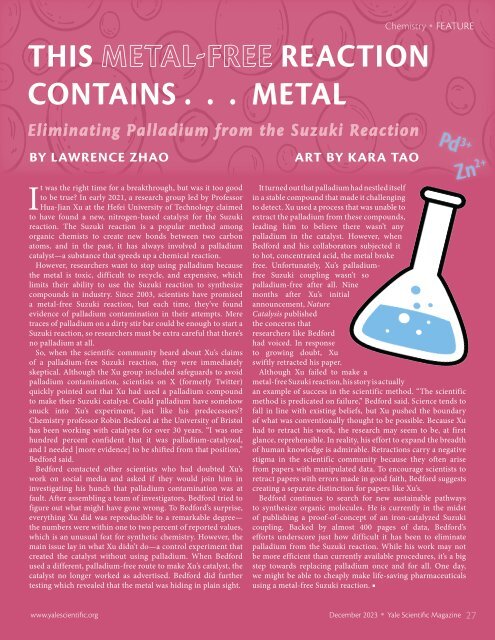YSM Issue 96.4
You also want an ePaper? Increase the reach of your titles
YUMPU automatically turns print PDFs into web optimized ePapers that Google loves.
Chemistry<br />
FEATURE<br />
THIS METAL-FREE REACTION<br />
CONTAINS . . . METAL<br />
Eliminating Palladium from the Suzuki Reaction<br />
BY LAWRENCE ZHAO<br />
It was the right time for a breakthrough, but was it too good<br />
to be true? In early 2021, a research group led by Professor<br />
Hua-Jian Xu at the Hefei University of Technology claimed<br />
to have found a new, nitrogen-based catalyst for the Suzuki<br />
reaction. The Suzuki reaction is a popular method among<br />
organic chemists to create new bonds between two carbon<br />
atoms, and in the past, it has always involved a palladium<br />
catalyst—a substance that speeds up a chemical reaction.<br />
However, researchers want to stop using palladium because<br />
the metal is toxic, difficult to recycle, and expensive, which<br />
limits their ability to use the Suzuki reaction to synthesize<br />
compounds in industry. Since 2003, scientists have promised<br />
a metal-free Suzuki reaction, but each time, they’ve found<br />
evidence of palladium contamination in their attempts. Mere<br />
traces of palladium on a dirty stir bar could be enough to start a<br />
Suzuki reaction, so researchers must be extra careful that there’s<br />
no palladium at all.<br />
So, when the scientific community heard about Xu’s claims<br />
of a palladium-free Suzuki reaction, they were immediately<br />
skeptical. Although the Xu group included safeguards to avoid<br />
palladium contamination, scientists on X (formerly Twitter)<br />
quickly pointed out that Xu had used a palladium compound<br />
to make their Suzuki catalyst. Could palladium have somehow<br />
snuck into Xu’s experiment, just like his predecessors’?<br />
Chemistry professor Robin Bedford at the University of Bristol<br />
has been working with catalysts for over 30 years. “I was one<br />
hundred percent confident that it was palladium-catalyzed,<br />
and I needed [more evidence] to be shifted from that position,”<br />
Bedford said.<br />
Bedford contacted other scientists who had doubted Xu’s<br />
work on social media and asked if they would join him in<br />
investigating his hunch that palladium contamination was at<br />
fault. After assembling a team of investigators, Bedford tried to<br />
figure out what might have gone wrong. To Bedford’s surprise,<br />
everything Xu did was reproducible to a remarkable degree—<br />
the numbers were within one to two percent of reported values,<br />
which is an unusual feat for synthetic chemistry. However, the<br />
main issue lay in what Xu didn’t do—a control experiment that<br />
created the catalyst without using palladium. When Bedford<br />
used a different, palladium-free route to make Xu’s catalyst, the<br />
catalyst no longer worked as advertised. Bedford did further<br />
testing which revealed that the metal was hiding in plain sight.<br />
ART BY KARA TAO<br />
Pd 3+<br />
It turned out that palladium had nestled itself<br />
in a stable compound that made it challenging<br />
to detect. Xu used a process that was unable to<br />
extract the palladium from these compounds,<br />
leading him to believe there wasn’t any<br />
palladium in the catalyst. However, when<br />
Bedford and his collaborators subjected it<br />
to hot, concentrated acid, the metal broke<br />
free. Unfortunately, Xu’s palladiumfree<br />
Suzuki coupling wasn’t so<br />
palladium-free after all. Nine<br />
months after Xu’s initial<br />
announcement, Nature<br />
Catalysis published<br />
the concerns that<br />
researchers like Bedford<br />
had voiced. In response<br />
to growing doubt, Xu<br />
swiftly retracted his paper.<br />
Although Xu failed to make a<br />
metal-free Suzuki reaction, his story is actually<br />
an example of success in the scientific method. “The scientific<br />
method is predicated on failure,” Bedford said. Science tends to<br />
fall in line with existing beliefs, but Xu pushed the boundary<br />
of what was conventionally thought to be possible. Because Xu<br />
had to retract his work, the research may seem to be, at first<br />
glance, reprehensible. In reality, his effort to expand the breadth<br />
of human knowledge is admirable. Retractions carry a negative<br />
stigma in the scientific community because they often arise<br />
from papers with manipulated data. To encourage scientists to<br />
retract papers with errors made in good faith, Bedford suggests<br />
creating a separate distinction for papers like Xu’s.<br />
Bedford continues to search for new sustainable pathways<br />
to synthesize organic molecules. He is currently in the midst<br />
of publishing a proof-of-concept of an iron-catalyzed Suzuki<br />
coupling. Backed by almost 400 pages of data, Bedford’s<br />
efforts underscore just how difficult it has been to eliminate<br />
palladium from the Suzuki reaction. While his work may not<br />
be more efficient than currently available procedures, it’s a big<br />
step towards replacing palladium once and for all. One day,<br />
we might be able to cheaply make life-saving pharmaceuticals<br />
using a metal-free Suzuki reaction. ■<br />
Zn 2+<br />
www.yalescientific.org<br />
December 2023 Yale Scientific Magazine 27

















